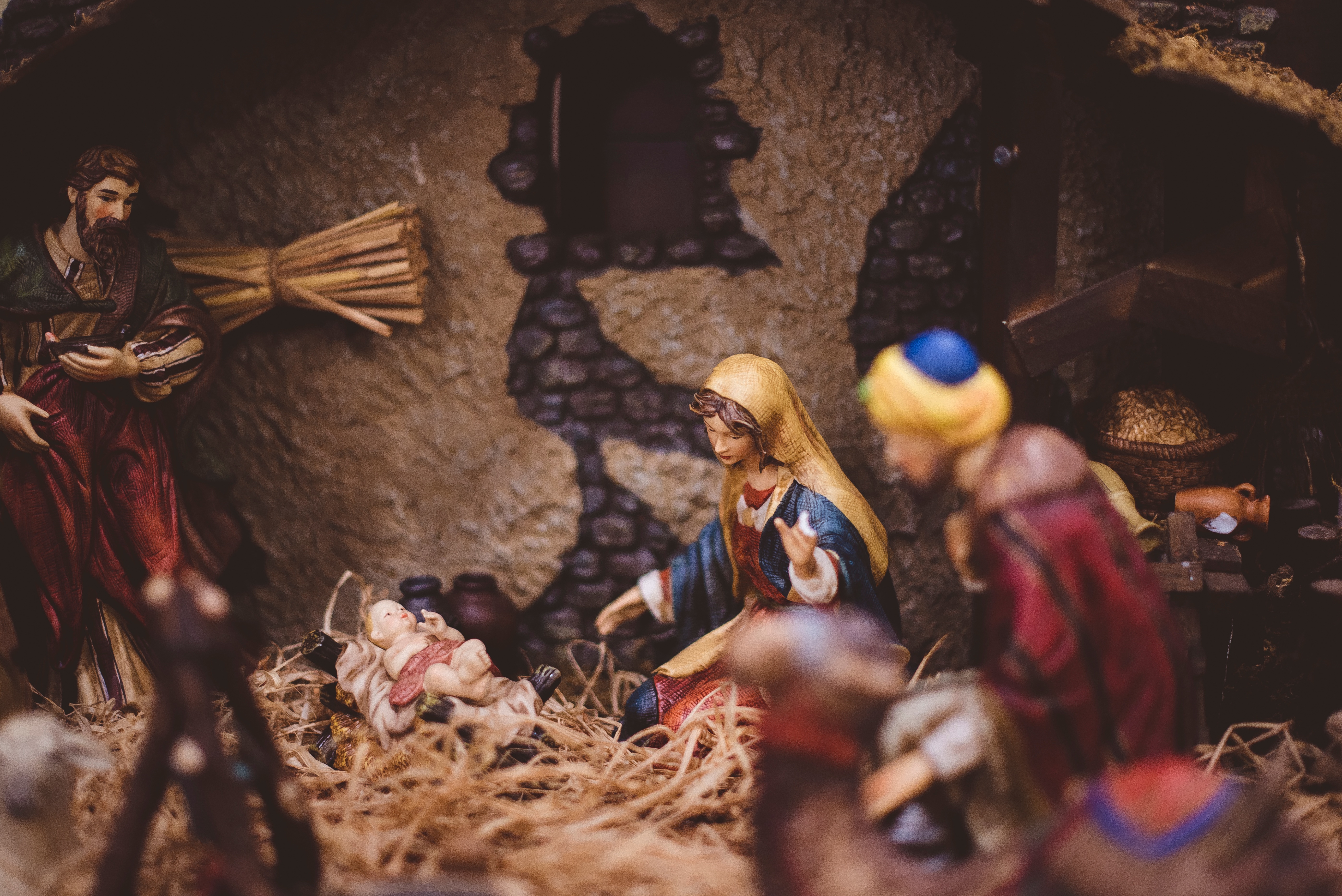Who is this babe lying in a manger? Mark Lowry famously quipped, “Mary did you know that your baby boy will give sight to a blind man? Mary did you know that your baby boy will calm a storm with his hand? Did you know that your baby boy has walked where angels trod? And when you kiss your little baby, you have kissed the face of God.”[1] Who is this most celebrated baby? Why all the fuss? This child was special in many ways. In fact, the Child is in fact God come to earth. How do we know this and why is this still controversial?
I have confronted a few people who still hold to the idea that the divinity of Christ was a concept developed by Emperor Constantine in the 4th century AD.[2] Such an idea is not rooted in history but a false assumption based upon the edict of the Nicene Council in 325 AD to condemn the ideas of Arius and uphold the ideas of Athanasius.[3] Constantine simply ordered that the church solve the Arian controversy as it was causing great ecclesiastical problems which could cause societal fragmentation.
Arius taught that Jesus was merely a human person and the eternal God. His greatest concern “was the premise that God is an undifferentiated whole. On this basis he argued that the Logos or Son is a creature and therefore must have had a beginning.”[4] Thus, Arius held that Jesus held a position higher than humanity, but lower than God the Father.
Athanasius argued that Jesus was fully divine in all aspects. Athanasius stated that “The Word was made man in order that we might be made divine.”[5] By “made divine,” Athanasius was noting the relationship that humanity held with the divine, being elevated to the level of eternity and perfected in God’s sinlessness. Based upon the Scriptures, the Council declared,
But to those who say, Once he was not, or he was not before his generation, or he came to be out of nothing, or who assert that he, the Son of God, is of a different hypostasis or ousia, or that he is a creature, or changeable, or mutable, the Catholic and Apostolic Church anathematizes them.[6]
But what basis did the Council use to uphold Athanasius’ teaching and condemn Arius’? They used the Scriptures and the teachings of the early church. How do we know this Babe lying in a manger was in fact divine?
The Divine Nature of The Babe Lying in a Manger was Prophesied.
I recently delivered a message on Zechariah 12. I noticed something that stood out to me that had not in my previous readings. The chapter begins with the words “Thus declares the LORD, who stretched out the heavens and founded the earth and formed the spirit of man within him…” (Zechariah 12:1b).[7] Throughout the chapter, first-person language is employed indicating that the speaker is referencing himself. God is the speaker and later says, “And I will pour out on the house of David and the inhabitants of Jerusalem a spirit of grace and pleas for mercy, so that, when they look on me, on him whom they have pierced, they shall mourn for him, as one mourns for an only child, and weep bitterly over him, as one weeps over a firstborn” (Zechariah 12:10). Remember, God is speaking and he uses first-person language. Thus, God is claiming that he would come to earth and would be pierced for the transgressions of mankind. John the apostle understands this prophecy to have been fulfilled in Christ when, after referring to Christ’s crucifixion, he writes, “And again another Scripture says, ‘They will look on him whom they have pierced” (John 19:37). Again in Revelation, this prophecy is referenced when Christ returns, stating, “Behold, he is coming with the clouds, and every eye will see him, even those who pierced him, and all tribes of the earth will wail on account of him. Even so. Amen” (Revelation 1:7). Another element of Jesus’ divine nature is seen in addition to prophecy.
The Divine Nature of the Babe Lying in a Manger was Professed.
Jesus himself understood himself to be divine. Jesus refers to himself as the Son of Man who had access to the Ancient of Days[8] (see Daniel 7:10) in Mark 8:38. Again, the “I am” of Jesus indicates the knowledge that he was in fact God come in the flesh.[9] Several other passages could be offered, but space does not allow such treatment.
John the apostle clearly understood Jesus to be co-eternal with the Father when he denotes, “In the beginning was the Word, and the Word was with God, and the Word was God. He was in the beginning with God. All things were made through him, and without him was not any thing made that was made” (John 1:1-3). As C. S. Lewis notes,
A man who was merely a man and said the sort of things Jesus said would not be a great moral teacher. He would either be a lunatic—on a level with the man who says he is a poached egg—or else he would be the Devil of Hell. You must make your choice. Either this man was, and is, the Son of God: or else a madman or something worse. You can shut Him up for a fool, you can spit at Him and kill Him as a demon; or you can fall at His feet and call Him Lord and God. But let us not come with any patronizing nonsense about His being a great human teacher. He has not left that open to us. He did not intend to.[10]
Jesus understood himself to be the Son of God as he claimed a divine status. But Jesus not only claimed to be divine, he demonstrated his divine nature in another fashion.
The Divine Nature of the Babe Lying in a Manger was Proven.
One of the coolest things about Jesus is the fact that he did not just say something about himself, he proved it. Jesus would prove his divine nature by the miracles that he performed (e.g., Mark 2:1-12). He proved his divine nature by casting out demons by his mere word (e.g., Luke 8:26-39). He proved his divine nature by performing supernatural works over nature (e.g., Luke 8:22-25). Jesus proved his divine nature by raising the dead (e.g., John 11:38-44). Finally, Jesus’ divine nature was proven by his own resurrection from the dead (Matthew 28; Mark 16:1-8; Luke 24; and John 20:1-21:25).
Conclusion
This Christmas, we celebrate a most marvelous birth. It is the birth of Jesus of Nazareth who is the Christ, the Son of Almighty God. How amazing the incarnation truly is! Ponder about the amazing nature of this event. Mary would give birth to the One who gave her life. Mary would bring forth the One who would save her soul. The most powerful Being in all the universe would humble himself to be born in a humble manger.
While we often stress ourselves trying to find the perfect gift for our loved ones, it is helpful to understand that the greatest gift has already been given. The perfect gift was, is, and forever will be Jesus. This Child, as Paul notes,
who, though he was in the form of God, did not count equality with God a thing to be grasped, but made himself nothing, taking the form of a servant, being born in the likeness of men. And being found in human form, he humbled himself by becoming obedient to the point of death, even death on a cross. Therefore God has highly exalted him and bestowed on him the name that is above every name, so that at the name of Jesus every knee should bow, in heaven and on earth and under the earth, and every tongue confess that Jesus Christ is Lord, to the glory of the Father” (Philippians 2:6-11).
May we continue to remember, as the cliché goes, that Jesus truly is the reason for this celebratory season.
© December 19, 2016. Brian Chilton.
Notes
[1] Mark Lowry and Buddy Greene, Mary Did You Know, 1991.
[2] Constantine converted to Christianity. After his conversion, Constantine allowed the free exercise of Christian worship in the Roman Empire beginning in the 4th century.
[3] Saint Nicolas is said to have attended this conference. Nicolas is linked with the popular Santa Claus figure. Saint Nicolas was an ardent defender of orthodox Christianity. It is said that Nicolas smacked Arius due to his heretical concepts.
[4] Stanley J. Grenz, Theology for the Community of God (Grand Rapids; Cambridge, UK: Wm. B. Eerdmans, 1994), 248.
[5] Athanasius, De Incarnatione 54, in Early Christian Fathers, Henry Bettenson, ed. and trans. (New York: Oxford, 1969), 293.
[6] “The Creed of Nicea,” in The Creeds of the Churches, 3rd ed, John H. Leith, ed (Atlanta: John Knox, 1982), 31.
[7] Unless otherwise noted, all Scripture comes from the English Standard Version (Wheaton: Crossway, 2001, 2007).
[8] That is, God.
[9] See John 4:26; 6:20, 35, 48, 51; 8:12, 18, 24, 28, 58; 9:5; 10:7, 9, 11, 14; 11:25; 13:19; 14:6; 15:1; 18:5-6.
[10] C. S. Lewis, Mere Christianity (New York: MacMillian, 1943, 1952), 41.






Reblogged this on Talmidimblogging.
Thanks for sharing!
You’re very welcome my friend 😊